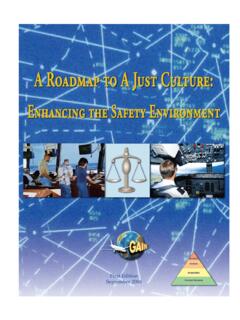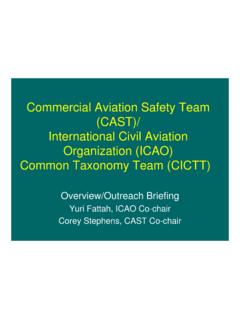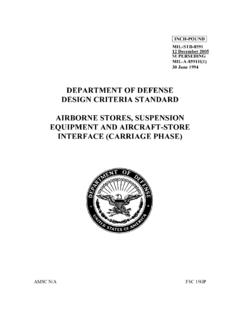Transcription of Flight Safety Digest May-June 1998
1 Flight SAFETYFLIGHT Safety FOUNDATIONMAY june 1998 DIGESTB oeing 757 CFIT Accident at Cali,Colombia, Becomes Focus ofLessons ULQ.. CLO .. ROZO274 R..NOT TO SCALE12000120001200012000100008000600040 001000080001400060004000600060004000202 193 193 013 193 5000'ApproximateTrack of Accident AircraftHAccident SiteROMEO274 R..6000 SPECIAL DOUBLE ISSUEF light Safety DigestVol. 17 No. 5/6 May june 1998 Flight Safety FOUNDATIONFor Everyone ConcernedWith the Safety of FlightOfficers and StaffStuart MatthewsChairman, President and CEOB oard of GovernorsJames S. Waugh VogtGeneral Counsel and SecretaryBoard of GovernorsADMINISTRATIVEN ancy RichardsExecutive SecretaryEllen PlaugherExecutive Support Corporate ServicesFINANCIALE lizabeth KirbyControllerTECHNICALR obert H. VandelDirector of Technical ProjectsRobert H. GouldManaging Director of Aviation Safety Auditsand Internal Evaluation ProgramsRobert FeelerManager of Aviation Safety AuditsRobert Dodd, , Data Systems and AnalysisJoanne AndersonTechnical AssistantMEMBERSHIPJoan PerrinDirector of Marketing and DevelopmentSusan M.
2 HudachekMembership Services ManagerAhlam WahdanAssistant to the Director of Membershipand DevelopmentDavid A. GrzeleckiLibrarian, Jerry Lederer Aviation Safety LibraryPUBLICATIONSR oger RozelleDirector of PublicationsRick DarbySenior EditorMark LacagninaSenior EditorWayne RosenkransSenior EditorJohn D. GreenCopyeditorKaren K. EhrlichProduction CoordinatorAnn L. MullikinAssistant Production CoordinatorJerome LedererPresident EmeritusIn This IssueFlight Safety Foundation (FSF) is an international membershiporganization dedicated to the continuous improvement of Flight and independent, FSF was launched in 1945 in response to theaviation industry s need for a neutral clearinghouse to disseminateobjective Safety information, and for a credible and knowledgeable bodythat would identify threats to Safety , analyze the problems and recommendpractical solutions to them. Since its beginning, the Foundation has actedin the public interest to produce positive influence on aviation , the Foundation provides leadership to more than 680 memberorganizations in 77 757 CFIT Accident at Cali, Colombia,Becomes Focus of Lessons LearnedThe author has identified 27 errors that he believes wereinvolved in the controlled- Flight -into-terrain accident.
3 Hisanalysis suggests specific operational methods and trainingstrategies that might prevent similar 1997 Rotorcraft Accident RateWas Lowest in Seven air-taxi accident rate also declined General Accounting OfficeReports Lag in Implementation of AirlineSecurity MeasuresNational Business Aviation Association marked its50th anniversary by publishing comprehensive history ofbusiness Ingestion Causes A320 EngineFailure and Fire during Takeoff1323437 Flight Safety FOUNDATION Flight Safety Digest MAY june 19981 Boeing 757 CFIT Accident at Cali, Colombia,Becomes Focus of Lessons LearnedThe author has identified 27 errors that he believes were involved in thecontrolled- Flight -into-terrain accident. His analysis suggests specific operationalmethods and training strategies that might prevent similar A. SimmonAt 2142 local time on Dec. 20, 1995, American Airlines (AA) Flight 965, a Boeing 757-223 on a regular, scheduled passengerflight from Miami, Florida, , to Cali, Colombia, struckmountainous terrain during a descent from cruise altitude invisual meteorological conditions under instrument Flight accident site was near the town of Buga, 33 nautical miles(61 kilometers) northeast of the Cali very high frequencyomnidirectional radio range (VOR).
4 The aircraft struck nearthe summit of El Deluvio, at the 8,900-foot (2,670-meter) level,approximately 10 nautical miles (19 kilometers) east of AirwayW3. Of the 163 passengers and crew on board, four passengerssurvived the its final report on the accident, the Aeron utica Civil of theRepublic of Colombia (Aeron utica Civil) said that theprobable causes of the accident were: The Flight crew s failure to adequately plan andexecute the approach to Runway 19 at SKCL [Cali sAlfonso Bonilla Aragon International Airport], andtheir inadequate use of automation; Failure of the Flight crew to discontinue the approachinto Cali, despite numerous cues alerting them of theinadvisability of continuing the approach; The lack of situational awareness of the flightcrew regarding vertical navigation, proximity toterrain and the relative location of critical radio aids;[and,] Failure of the Flight crew to revert to basic radionavigation at the time when the FMS [flightmanagement system]-assisted navigation becameconfusing and demanded an excessive workload in acritical phase of the Flight .
5 1 The Aeron utica Civil said that factors contributing to theaccident were: The Flight crew s ongoing efforts to expedite theirapproach and landing in order to avoid potentialdelays; The Flight crew s execution of the GPWS [ground-proximity warning system] escape maneuver while thespeed brakes remained deployed; FMS logic that dropped all intermediate fixes fromthe display(s) in the event of execution of a directrouting; [and,]2 Flight Safety FOUNDATION Flight Safety Digest MAY june 1998 FMS-generated navigational information that used adifferent naming convention from that published innavigational charts. Representatives from AA, the Allied Pilots Association (APA,the union that represents AA Flight crews) and the BoeingCommercial Airplane Group were parties to the accidentinvestigation. The article on page 19 summarizes the partysubmissions that were made to the Aeron utica Civil and National Transportation Safety Board (NTSB) regardingthe investigation, insofar as they added to or differed from theAeron utica Civil analysis of human errors that might have contributed tothis accident is based upon the aircraft-accident report of theAeron utica Civil and the NTSB factual reports from thechairmen of the Operations, Air Traffic Control (ATC), FlightData Recorder (FDR) and Cockpit Voice Recorder (CVR)groups.
6 (The NTSB assisted Colombian authorities in theaccident investigation.) Explanation of the asterisk and single-letter codes, and definitions of italicized human factors termsthat may not be familiar are in Taxonomy of Human Error, page 3. The analysis uses excerpts from the CVR complete CVR transcript is in Cockpit Voice RecorderTranscript, American Airlines Flight 965, Dec. 20, 1995, crew read back the wrong transponder code. (*),L, (approximately 2104)Shortly after contacting Bogota (Colombia) Control, AA 965was issued the following instruction: report ready for descentand please squawk code alpha two three one four. The captain (the pilot not flying [PNF]) said, OK squawktwo two one four uh and report ready for descent, gracias. This minor error had no bearing on the accident because thecontroller amended the transponder code to coincide with thecode acknowledged by the captain. This error is includedbecause human factors analysis must focus on the errorirrespective of the consequences of the Bogota controller did not advise the Cali controllerthat AA 965 was proceeding on a direct route to theTulua VOR.
7 (**), L, (2104:57 2105:50)At 2104:57, the controller at Cali Approach Controlreceived a telephone call from the controller at BogotaArea Control Center. The Bogota controller informed CaliApproach of the estimated arrival times and clearedaltitudes of the next three aircraft (including AA 965) that wereinbound to Cali. The Bogota controller did not, however, advisethe Cali controller that AA 965 was proceeding on a directroute to the Tulua VOR. This omission contributed to thesubsequent misunderstanding of the cleared to Cali VOR adequate approach review was not performed.(**), K, (2112 2126)Data indicate that an adequate approach review was notaccomplished by the Flight crew. There was no information onthe CVR either of an approach briefing or that the descentchecklist was performed. There was confusion about theaircraft s position and an absence of dialogue about plannedspeeds, crossing altitudes, radio tuning and management ofdisplays.
8 During this period, the captain was confused aboutthe meaning of ULQ, the Tulua VOR identifier. The CVRtranscript showed that there was concern about whether therewas time to retrieve the approach chart and that there was asound similar to rustling pages. The captain took 37 secondsto decide how to implement the amended clearance to Runway19, and he then requested clearance to Rozo (a nondirectionalbeacon radio navigation aid [NDB]).While one of the crewmembers did enter a preliminary arrivalpath to Runway 01 in the FMS during the Flight , this actiondid not constitute an adequate approach crewmembers review the approach prior to the top ofdescent. This is a low-workload period that allows eachcrewmember to assess the risks and problems associated withthe approach, determine the key physical features of theapproach area, derive appropriate operational constraints andcalculate the planned landing fuel and the minimum fuel thatwill be needed if a diversion to the alternate is necessary.
9 Thisprocess vigilance tuning will result in an appropriatefocus of attention for each approach review should have considered that theapproach (a) would be made at night, (b) at a terrain-criticalairport, (c) with a nonprecision approach (as well as aprecision approach), (d) without the benefit of radar and (e)in a country where the controller s native language (Spanish)was different from the crew s (English). These five conditionsare the common elements of most controlled- Flight -into-terrain (CFIT) Moreover, during this review, thecrew should have determined the overall approach strategy,management of the radios and displays, and delegation oftasks to manage workload and approach review prepares pilots for the approach, armsthem for problem solving, allows time for thought during theapproach and helps prevent distractions from the primaryresponsibility to control the Flight the approach review and briefing prior to top ofdescent and then flying the approach as briefed are idealbut not always possible because of operational changes inrunways, winds, traffic and other factors.
10 Pilots canaccommodate changes, however, as long as they haveconstructed a general mental picture of the physical featuresof the approach area, the basic approach geometry and itsphysical and operational constraints. This mental model isFLIGHT Safety FOUNDATION Flight Safety Digest MAY june 19983 Taxonomy of Human ErrorIn the accompanying analysis of human error in theaccident at Cali, Colombia, errors that are of major concernand are believed likely to have been a link in the chain ofevents leading to the accident are marked by threeasterisks (**); those that are of lesser concern but mayhave contributed to the accident are marked by twoasterisks (**); and those that are minor are marked by asingle asterisk (*).After the asterisk is a single-letter code for the most likelyclassification of each error using the taxonomy of JamesReason, professor of psychology at the University ofManchester (England): lapse = L; slip = S; rule-basedmistake = R; and knowledge-based mistake = (Fiveminor radio or read-back errors that are unlikely to havecontributed to the accident have been omitted.)







